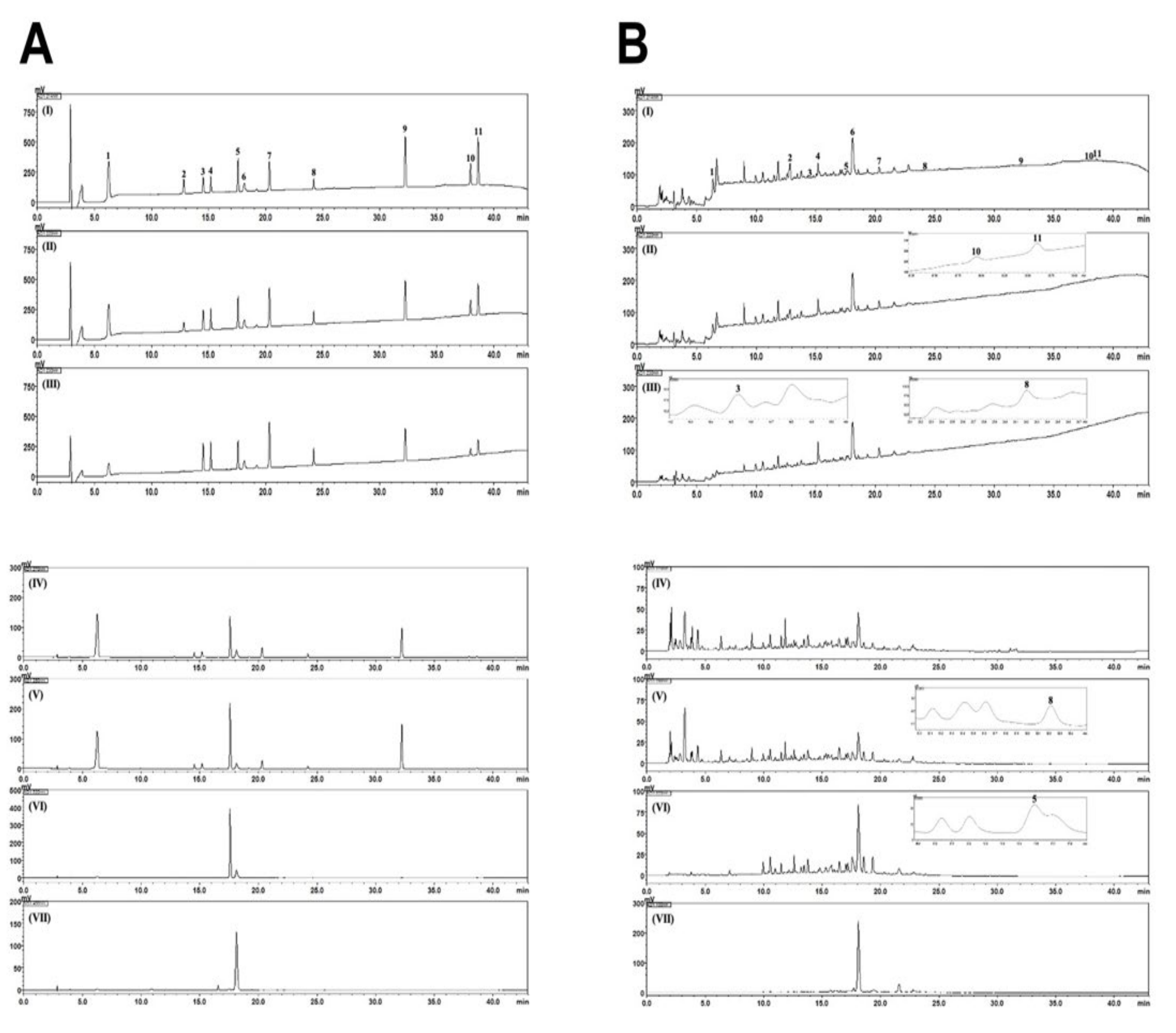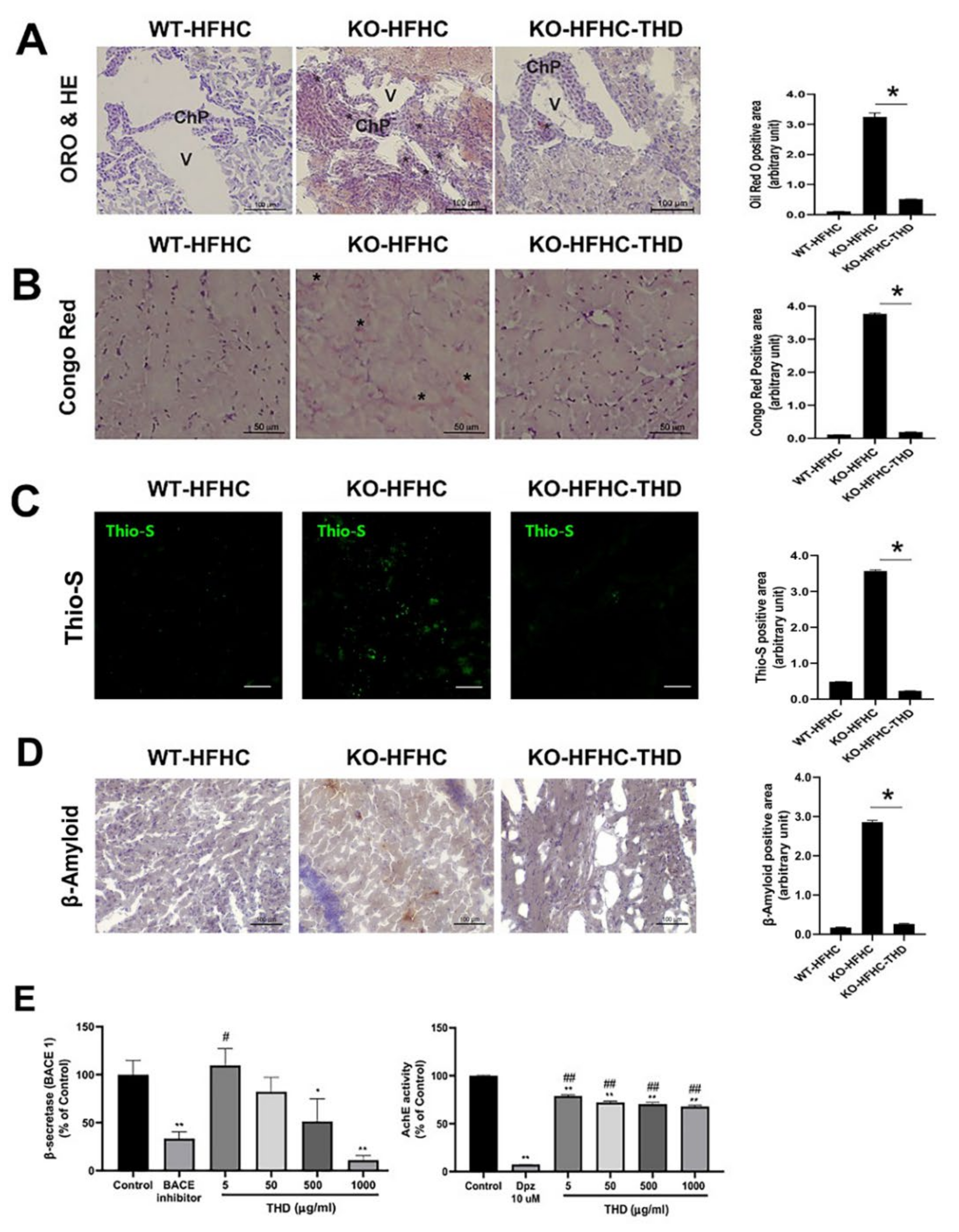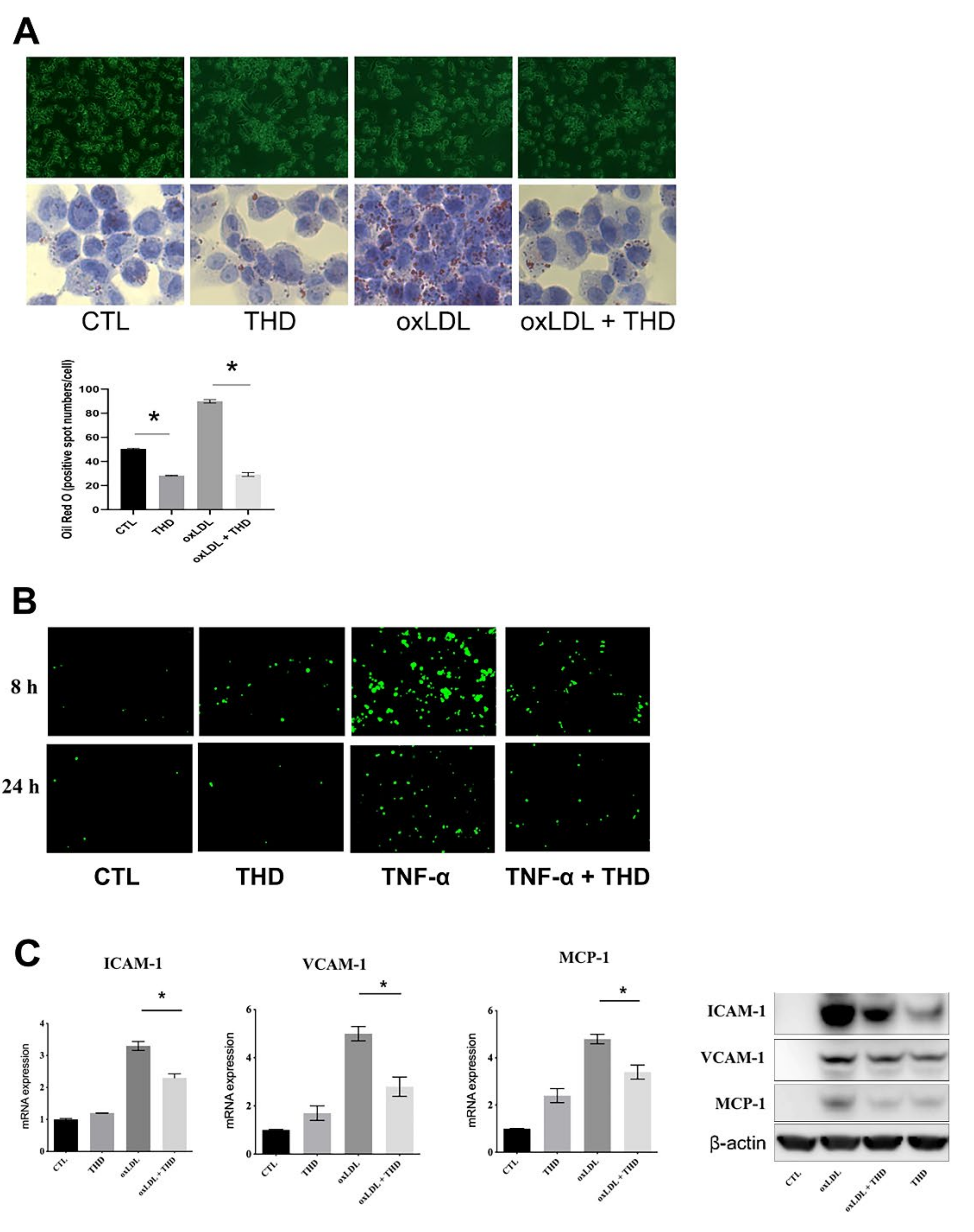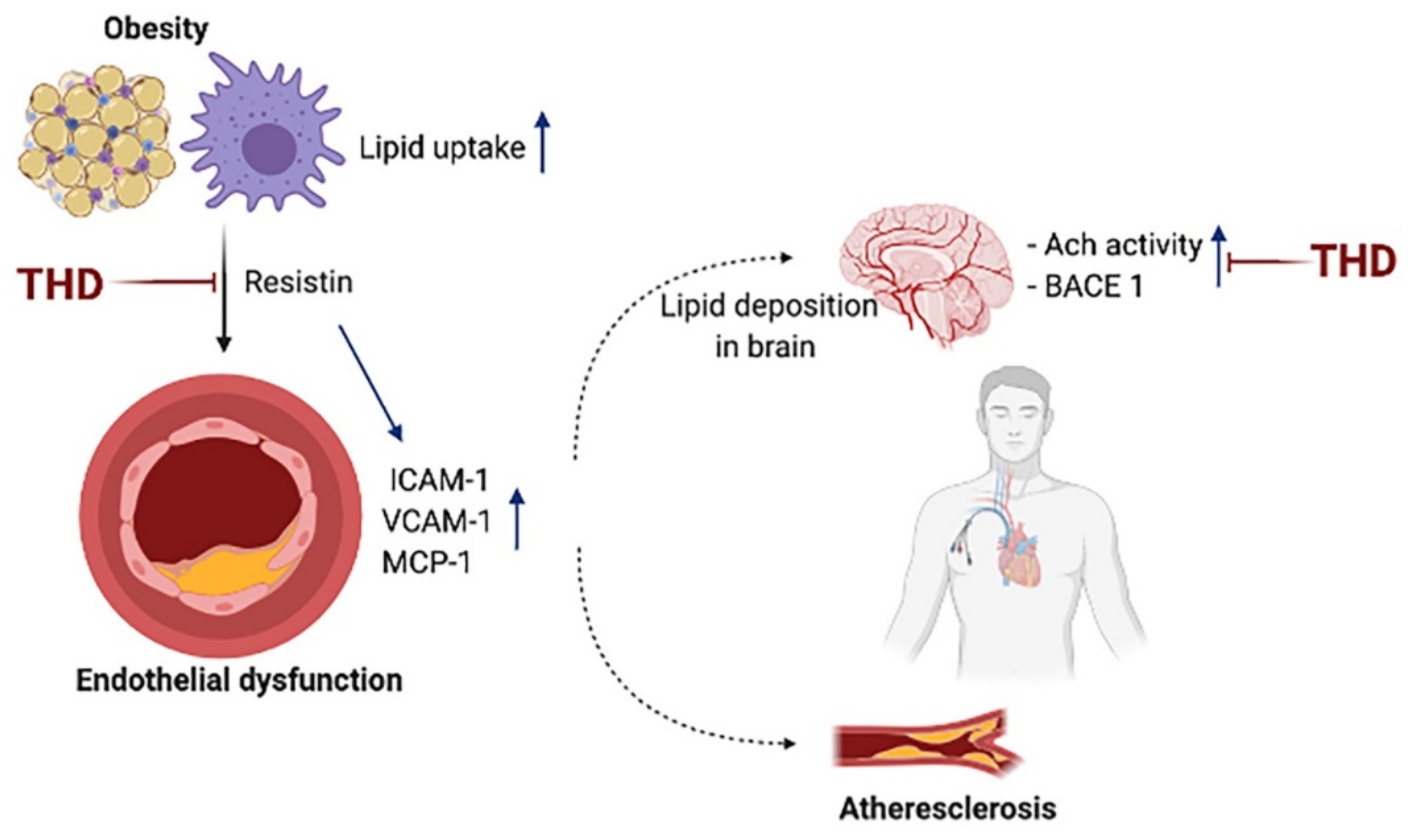Tongqiaohuoxue Hinders Development and Progression of Atherosclerosis: A Possible Role in Alzheimer’s Disease
Simple Summary
Abstract
1. Introduction
2. Materials and Methods
2.1. Chemicals and Reagents
2.2. HPLC Analysis of THD
2.3. THD Preparation
2.4. Animals
2.5. Evaluation of Atherosclerosis
2.6. Lipid Profiles
2.7. Cell Culture
2.8. LDL Isolation and Oxidation
2.9. Lipid Uptake Assay
2.10. ORO Staining
2.11. Monocyte Adhesion to Endothelial Cells
2.12. Quantitative Real-Time PCR
2.13. Analysis of Adipokine, BACE1 and AChE
2.14. Immunohistochemistry
2.15. Statistical Analysis
3. Results
3.1. Chemical Components in THD
3.2. Reduction of Atherogenic Plaque Formation with THD Treatment in ApoE-/- Mice
3.3. Attenuation of HFHC-Induced Lipid Deposition and amyloid-beta (Aβ) Plaque Formation in the Brains of ApoE-/- Mice
3.4. Attenuation of Lipid Uptake in Monocytes and Inhibition of Endothelial Cell Activation
3.5. Reduction in Serum Resistin in ApoE-/- Mice and Resistin Expression of Human Monocyte
4. Discussion
5. Conclusions
Supplementary Materials
Author Contributions
Funding
Acknowledgments
Conflicts of Interest
References
- John, T.O.; Hugh, S.M. Vascular Risk Factors and Alzheimer’s Disease. BMC Med. 2014, 12, 218. [Google Scholar]
- Van Exel, E.; Gussekloo, J.; Houx, P.; De Craen, A.; Macfarlane, P.; Der Wiel, A.B.-V.; Blauw, G.; Westendorp, R. Atherosclerosis and Cognitive Impairment Are Linked in the Elderly. The Leiden 85-Plus Study. Atherosclerosis 2002, 165, 353–359. [Google Scholar] [CrossRef]
- Viswanathan, A.; Rocca, W.A.; Tzourio, C. Vascular Risk Factors and Dementia: How to Move Forward? Neurology 2009, 72, 368–374. [Google Scholar] [CrossRef] [PubMed]
- Sparks, D.L. Coronary Artery Disease, Hypertension, ApoE, and Cholesterol: A Link to Alzheimer’s Disease? Ann. N. Y. Acad. Sci. 1997, 826, 128–146. [Google Scholar] [CrossRef]
- Casserly, I.; Topol, E. Convergence of Atherosclerosis and Alzheimer’s Disease: Inflammation, Cholesterol, and Misfolded Proteins. Lancet 2004, 363, 1139–1146. [Google Scholar] [CrossRef]
- Wilson, P.W.F.; Schaefer, E.J.; Larson, M.G.; Ordovas, J.M. Apolipoprotein E Alleles and Risk of Coronary Disease. Arterioscler. Thromb. Vasc. Biol. 1996, 16, 1250–1255. [Google Scholar] [CrossRef]
- Farrer, L.A.; Cupples, L.A.; Haines, J.L.; Hyman, B.; Kukull, W.A.; Mayeux, R.; Myers, R.H.; Pericak-Vance, M.A.; Risch, N.; Van Duijn, C.M. Effects of Age, Sex, and Ethnicity on the Association Between Apolipoprotein E Genotype and Alzheimer Disease. A Meta-Analysis. APOE and Alzheimer Disease Meta Analysis Consortium. JAMA 1997, 278, 1349–1356. [Google Scholar] [CrossRef]
- Yin, C.; Ackermann, S.; Ma, Z.; Mohanta, S.K.; Zhang, C.; Li, Y.; Nietzsche, S.; Westermann, M.; Peng, L.; Hu, D.; et al. ApoE Attenuates Unresolvable Inflammation by Complex Formation with Activated C1q. Nat. Med. 2019, 25, 496–506. [Google Scholar] [CrossRef]
- Wang, N.; Deng, Y.; Wei, W.; Song, L.; Wang, Y. Serum Containing Tongqiaohuoxue Decoction Suppresses Glutamate-Induced PC12 Cell Injury. Neural Regen. Res. 2012, 7, 1125–1131. [Google Scholar]
- Wang, G.; Wang, N.; Liao, H.-N. Effects of Muscone on the Expression of P-gp, MMP-9 on Blood–Brain Barrier Model In Vitro. Cell Mol. Neurobiol. 2015, 35, 1105–1115. [Google Scholar] [CrossRef]
- Ge, C.; Wang, X.-M.; Huang, Z.-G.; Xia, Q.; Wang, N.; Xu, D.-J. Tongqiao Huoxue Decoction Ameliorates Learning and Memory Defects in Rats With Vascular Dementia by up-Regulating the Ca(2+)-CaMKII-CREB pathway. Chin. J. Nat. Med. 2015, 13, 823–830. [Google Scholar] [CrossRef]
- Kim, S.-H.; Park, H.-S.; Hong, M.J.; Yoo, J.Y.; Lee, H.; Lee, J.A.; Hur, J.; Kwon, D.Y.; Kim, M.-S. Tongqiaohuoxue Decoction Ameliorates Obesity-Induced Inflammation and the Prothrombotic State by Regulating Adiponectin and Plasminogen Activator Inhibitor -1. J. Ethnopharmacol. 2016, 192, 201–209. [Google Scholar] [CrossRef] [PubMed]
- Lee, J.; Jun, M. Dual BACE1 and Cholinesterase Inhibitory Effects of Phlorotannins from Ecklonia cava—An In Vitro and in Silico Study. Mar. Drugs 2019, 17, 91. [Google Scholar] [CrossRef] [PubMed]
- Lazar, M.A. Resistin-and Obesity-associated Metabolic Diseases. Horm. Metab. Res. 2007, 39, 710–716. [Google Scholar] [CrossRef] [PubMed]
- Ross, R. Atherosclerosis Is an Inflammatory Disease. Am. Heart J. 1999, 138, S419–S420. [Google Scholar] [CrossRef]
- Gaudreault, N.; Kumar, N.; Posada, J.M.; Stephens, K.B.; De Mochel, N.S.R.; Eberlé, D.; Olivas, V.R.; Kim, R.; Harms, M.J.; Johnson, A.; et al. ApoE Suppresses Atherosclerosis by Reducing Lipid Accumulation in Circulating Monocytes and the Expression of Inflammatory Molecules on Monocytes and Vascular Endothelium. Arterioscler. Thromb. Vasc. Biol. 2011, 32, 264–272. [Google Scholar] [CrossRef] [PubMed]
- Hofman, A.; Ott, A.; Breteler, M.M.; Bots, M.L.; Slooter, A.J.; Van Harskamp, F.; Van Duijn, C.N.; Van Broeckhoven, C.; Grobbee, D.E. Atherosclerosis, Apolipoprotein E, and Prevalence of Dementia and Alzheimer’s Disease in the Rotterdam Study. Lancet 1997, 349, 151–154. [Google Scholar] [CrossRef]
- Kelleher, R.J.; Soiza, R.L. Evidence of Endothelial Dysfunction in the Development of Alzheimer’s Disease: Is Alzheimer’s a Vascular Disorder? Am. J. Cardiovasc. Dis. 2013, 3, 197–226. [Google Scholar]
- Lv, J.; Xiong, W.; Lei, T.; Wang, H.; Sun, M.; Hao, E.; Wang, Z.; Huang, X.; Deng, S.; Deng, J.; et al. Amygdalin Ameliorates the Progression of Atherosclerosis in Ldl Receptor Deficient Mice. Mol. Med. Rep. 2017, 16, 8171–8179. [Google Scholar] [CrossRef]
- Jin, L.; Zhang, L.-M.; Xie, K.-Q.; Ye, Y.; Feng, L. Paeoniflorin Suppresses the Expression of Intercellular Adhesion Molecule-1 (ICAM-1) in Endotoxin-Treated Human Monocytic Cells. Br. J. Pharmacol. 2011, 164, 694–703. [Google Scholar] [CrossRef]
- Mahley, R.W. Apolipoprotein E: From Cardiovascular Disease to Neurodegenerative Disorders. J. Mol. Med. 2016, 94, 739–746. [Google Scholar] [CrossRef] [PubMed]
- Holtzman, D.M.; Herz, J.; Bu, G. Apolipoprotein E and Apolipoprotein E Receptors: Normal Biology and Roles in Alzheimer Disease. Cold Spring Harb. Perspect. Med. 2012, 2, a006312. [Google Scholar] [CrossRef] [PubMed]
- Kanekiyo, T.; Xu, H.; Bu, G. ApoE and Abeta in Alzheimer’s Disease: Accidental Encounters or Partners? Neuron 2014, 81, 740–754. [Google Scholar] [CrossRef] [PubMed]
- Nishitsuji, K.; Hosono, T.; Nakamura, T.; Bu, G.; Michikawa, M. Apolipoprotein E Regulates the Integrity of Tight Junctions in an Isoform-Dependent Manner in an In Vitro Blood-Brain Barrier Model. J. Biol. Chem. 2011, 286, 17536–17542. [Google Scholar] [CrossRef]
- Li, L.; Wang, N.; Jin, Q.; Wu, Q.; Liu, Y.; Wang, Y. Protection of Tong-Qiao-Huo-Xue Decoction against Cerebral Ischemic Injury through Reduction Blood–Brain Barrier Permeability. Chem. Pharm. Bull. 2017, 65, 1004–1010. [Google Scholar] [CrossRef]
- Goldmann, T.; Wieghofer, P.; Jordão, M.J.C.; Prutek, F.; Hagemeyer, N.; Frenzel, K.; Amann, L.; Staszewski, O.; Kierdorf, K.; Krueger, M.; et al. Origin, Fate and Dynamics of Macrophages at Central Nervous System Interfaces. Nat. Immunol. 2016, 17, 797–805. [Google Scholar] [CrossRef]
- Lun, M.P.; Monuki, E.S.; Lehtinen, M.K. Development and Functions of the Choroid Plexus–Cerebrospinal Fluid System. Nat. Rev. Neurosci. 2015, 16, 445–457. [Google Scholar] [CrossRef]
- Moore, G.R.W.; Laule, C.; Leung, E.; Pavlova, V.; Morgan, B.P.; Esiri, M.M. Complement and Humoral Adaptive Immunity in the Human Choroid Plexus: Roles for Stromal Concretions, Basement Membranes, and Epithelium. J. Neuropathol. Exp. Neurol. 2016, 75, 415–428. [Google Scholar] [CrossRef]
- Ransohoff, R.M.; Engelhardt, B. The Anatomical and Cellular Basis of Immune Surveillance in the Central Nervous System. Nat. Rev. Immunol. 2012, 12, 623–635. [Google Scholar] [CrossRef]
- Schwartz, M.; Baruch, K. The Resolution of Neuroinflammation in Neurodegeneration: Leukocyte Recruitment via the Choroid Plexus. EMBO J. 2014, 33, 7–22. [Google Scholar] [CrossRef]
- Bokarewa, M.; Nagaev, I.; Dahlberg, L.; Smith, U.; Tarkowski, A. Resistin, an Adipokine with Potent Proinflammatory Properties. J. Immunol. 2005, 174, 5789–5795. [Google Scholar] [CrossRef] [PubMed]
- Lee, S.; Lee, H.-C.; Kwon, Y.-W.; Lee, S.E.; Cho, Y.; Kim, J.; Lee, S.; Kim, J.-Y.; Lee, J.; Yang, H.-M.; et al. Adenylyl Cyclase-Associated Protein 1 Is a Receptor for Human Resistin and Mediates Inflammatory Actions of Human Monocytes. Cell Metab. 2014, 19, 484–497. [Google Scholar] [CrossRef] [PubMed]
- Reilly, M.P.; Lehrke, M.; Wolfe, M.L.; Rohatgi, A.; Lazar, M.A.; Rader, D.J. Resistin Is an Inflammatory Marker of Atherosclerosis in Humans. Circulation 2005, 111, 932–939. [Google Scholar] [CrossRef]
- Misiak, B.; Leszek, J.; Kiejna, A. Metabolic Syndrome, Mild Cognitive Impairment and Alzheimer’s Disease—The Emerging Role of Systemic Low-Grade Inflammation and Adiposity. Brain Res. Bull. 2012, 89, 144–149. [Google Scholar] [CrossRef] [PubMed]
- Bednarska-Makaruk, M.; Graban, A.; Wiśniewska, A.; Łojkowska, W.; Bochyńska, A.; Gugała-Iwaniuk, M.; Sławińska, K.; Ługowska, A.; Ryglewicz, D.; Wehr, H. Association of Adiponectin, Leptin and Resistin With Inflammatory Markers and Obesity in Dementia. Biogerontology 2017, 18, 561–580. [Google Scholar] [CrossRef]
- Hu, W.T.; Chen-Plotkin, A.; Arnold, S.E.; Grossman, M.; Clark, C.M.; Shaw, L.M.; Pickering, E.; Kuhn, M.; Chen, Y.; McCluskey, L.; et al. Novel CSF Biomarkers for Alzheimer’s Disease and Mild Cognitive Impairment. Acta Neuropathol. 2010, 119, 669–678. [Google Scholar] [CrossRef] [PubMed]
- Leung, Y.Y.; Toledo, J.B.; Nefedov, A.; Polikar, R.; Raghavan, N.; Xie, S.X.; Farnum, M.; Schultz, T.; Baek, Y.; Deerlin, V.V.; et al. Identifying Amyloid Pathology-Related Cerebrospinal Fluid Biomarkers for Alzheimer’s Disease in a Multicohort Study. Alzheimers Dement. 2015, 1, 339–348. [Google Scholar] [CrossRef] [PubMed]







Publisher’s Note: MDPI stays neutral with regard to jurisdictional claims in published maps and institutional affiliations. |
© 2020 by the authors. Licensee MDPI, Basel, Switzerland. This article is an open access article distributed under the terms and conditions of the Creative Commons Attribution (CC BY) license (http://creativecommons.org/licenses/by/4.0/).
Share and Cite
Ha, E.; Kim, M.; Chun, J.; Seo, C.-S.; Ahn, Y.; Jung, J. Tongqiaohuoxue Hinders Development and Progression of Atherosclerosis: A Possible Role in Alzheimer’s Disease. Biology 2020, 9, 363. https://doi.org/10.3390/biology9110363
Ha E, Kim M, Chun J, Seo C-S, Ahn Y, Jung J. Tongqiaohuoxue Hinders Development and Progression of Atherosclerosis: A Possible Role in Alzheimer’s Disease. Biology. 2020; 9(11):363. https://doi.org/10.3390/biology9110363
Chicago/Turabian StyleHa, Eunyoung, Mikyung Kim, Jaemoo Chun, Chang-Seob Seo, YouMee Ahn, and Jeeyoun Jung. 2020. "Tongqiaohuoxue Hinders Development and Progression of Atherosclerosis: A Possible Role in Alzheimer’s Disease" Biology 9, no. 11: 363. https://doi.org/10.3390/biology9110363
APA StyleHa, E., Kim, M., Chun, J., Seo, C.-S., Ahn, Y., & Jung, J. (2020). Tongqiaohuoxue Hinders Development and Progression of Atherosclerosis: A Possible Role in Alzheimer’s Disease. Biology, 9(11), 363. https://doi.org/10.3390/biology9110363





